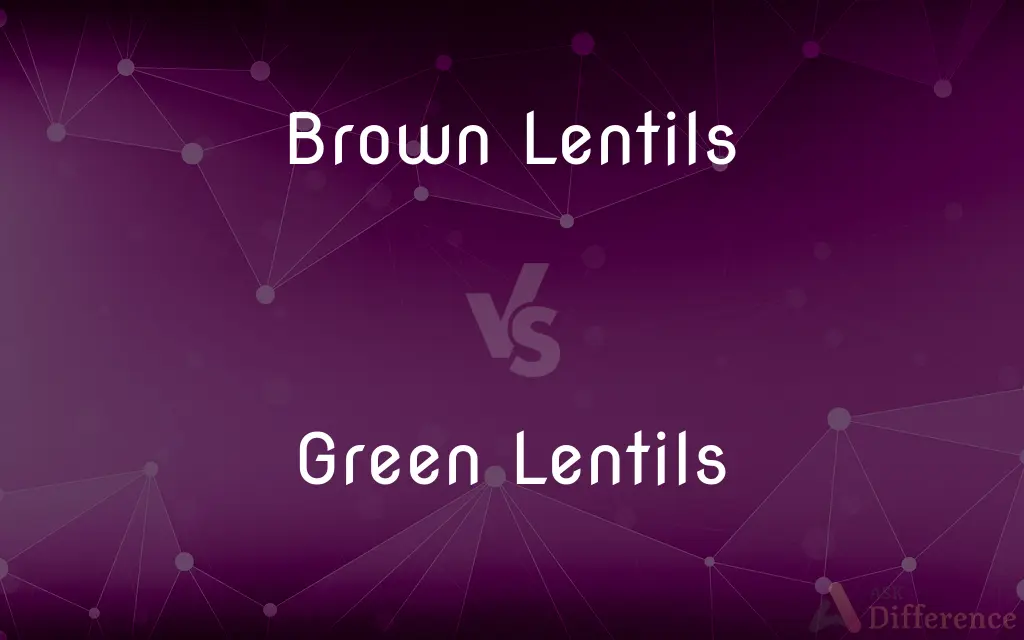Brown Lentils vs. Green Lentils — What's the Difference?
By Maham Liaqat & Fiza Rafique — Published on May 13, 2024
Brown lentils, common and versatile, cook quickly and tend to soften, making them ideal for soups and stews. Green lentils, firmer and peppery, hold their shape well, perfect for salads and side dishes.

Difference Between Brown Lentils and Green Lentils
Table of Contents
ADVERTISEMENT
Key Differences
Brown lentils are a staple in many pantries due to their wide availability and quick cooking time, typically requiring about 20-30 minutes. Their soft texture upon cooking makes them a favorite for dishes where a mushier consistency is desired, like thick soups or blended patties.
Green lentils, on the other hand, take a bit longer to cook, usually around 30-45 minutes, but their effort is rewarded with a firmer texture that stands up well in dishes needing distinct lentil shapes, such as salads or as a meat substitute in tacos. Their slightly peppery flavor also adds a distinct taste profile.
Nutritionally, both lentils are powerhouses, packed with protein, fiber, and minerals like iron and magnesium. However, green lentils have a slight edge in dietary fiber content, making them a bit more beneficial for digestive health.
From a culinary perspective, brown lentils' softer texture means they absorb flavors well, making them suitable for dishes with rich, savory sauces. Green lentils, with their robust structure, are better for lighter dishes where they can be a feature ingredient without disintegrating.
In terms of storage and shelf life, both lentils have similar requirements — cool, dry places away from direct sunlight. However, green lentils, due to their slightly harder shell, may have a marginally longer shelf life, retaining their quality and flavor a bit longer than brown lentils.
ADVERTISEMENT
Comparison Chart
Cooking Time
20-30 minutes
30-45 minutes
Texture
Soften and can become mushy
Retain firmness and shape
Flavor
Mild, earthy
Peppery, more pronounced
Best Used In
Soups, stews, purees
Salads, side dishes, as a meat substitute
Nutritional Benefit
High in protein and iron
Higher in dietary fiber
Shelf Life
Long, but slightly shorter than green lentils
Slightly longer due to firmer shell
Compare with Definitions
Brown Lentils
Quick-cooking and versatile.
Brown lentils are my go-to for a quick, nutritious soup.
Green Lentils
Hold their shape well, ideal for salads.
Green lentils added a nice bite to the salad.
Brown Lentils
Mild and earthy in flavor.
Brown lentils add a subtle, earthy base to the curry.
Green Lentils
Have a peppery flavor.
The peppery taste of green lentils enhanced the dish.
Brown Lentils
Tend to soften and blend into dishes.
The brown lentils perfectly thickened the stew.
Green Lentils
Used as a meat substitute in recipes.
Green lentils served as a great meat substitute in the taco filling.
Brown Lentils
A staple in vegetarian cooking for their protein content.
She uses brown lentils to boost the protein in her vegetarian meals.
Green Lentils
High in dietary fiber.
Green lentils are a great source of dietary fiber, aiding in digestion.
Brown Lentils
Ideal for absorbing flavors.
Brown lentils soaked up the savory sauce, making the dish delicious.
Green Lentils
Require longer cooking time.
She simmered the green lentils for 45 minutes until tender.
Common Curiosities
Are green lentils healthier than brown lentils?
Both are nutritious, but green lentils have a slight edge in dietary fiber content.
Do brown and green lentils taste the same?
No, brown lentils have a milder, earthier taste, while green lentils are slightly peppery and more pronounced in flavor.
Can I substitute green lentils for brown lentils in a recipe?
Yes, but the texture and cooking time may vary, affecting the final dish's consistency and flavor profile.
Do lentils require soaking before cooking?
No, lentils do not require soaking before cooking, but rinsing them is recommended to remove any debris.
Do lentils contain antioxidants?
Yes, lentils are a good source of antioxidants and phytochemicals, contributing to overall health.
What are brown lentils good for?
Brown lentils are great for dishes where a softer texture is desired, such as soups, stews, and purees.
Why choose green lentils?
Choose green lentils for dishes that benefit from a firmer texture, like salads or as a meat substitute in various recipes.
How can I thicken a dish with lentils?
Brown lentils are particularly good for thickening dishes due to their softer texture when cooked.
How should I store lentils?
Store both brown and green lentils in a cool, dry place away from direct sunlight to maintain their quality.
Can I cook brown and green lentils together?
While possible, their different cooking times mean one type may become mushy while the other retains its shape.
Are lentils gluten-free?
Yes, lentils are naturally gluten-free, making them a great choice for those with gluten sensitivities or celiac disease.
What's the environmental impact of growing lentils?
Lentils have a low environmental impact, requiring less water and fertilizer than many other crops, and they enrich the soil with nitrogen.
Can lentils be eaten cold?
Yes, especially green lentils, which are excellent in cold salads due to their ability to retain shape and texture.
How can I make lentils more digestible?
Rinsing lentils and cooking them thoroughly can help make them more digestible and reduce antinutrients.
Can I freeze cooked lentils?
Yes, both brown and green lentils freeze well and can be stored for future use in cooked dishes.
Share Your Discovery

Previous Comparison
BSPT vs. NPT
Next Comparison
Soccer Cleats vs. Baseball CleatsAuthor Spotlight
Written by
Maham LiaqatCo-written by
Fiza RafiqueFiza Rafique is a skilled content writer at AskDifference.com, where she meticulously refines and enhances written pieces. Drawing from her vast editorial expertise, Fiza ensures clarity, accuracy, and precision in every article. Passionate about language, she continually seeks to elevate the quality of content for readers worldwide.













































